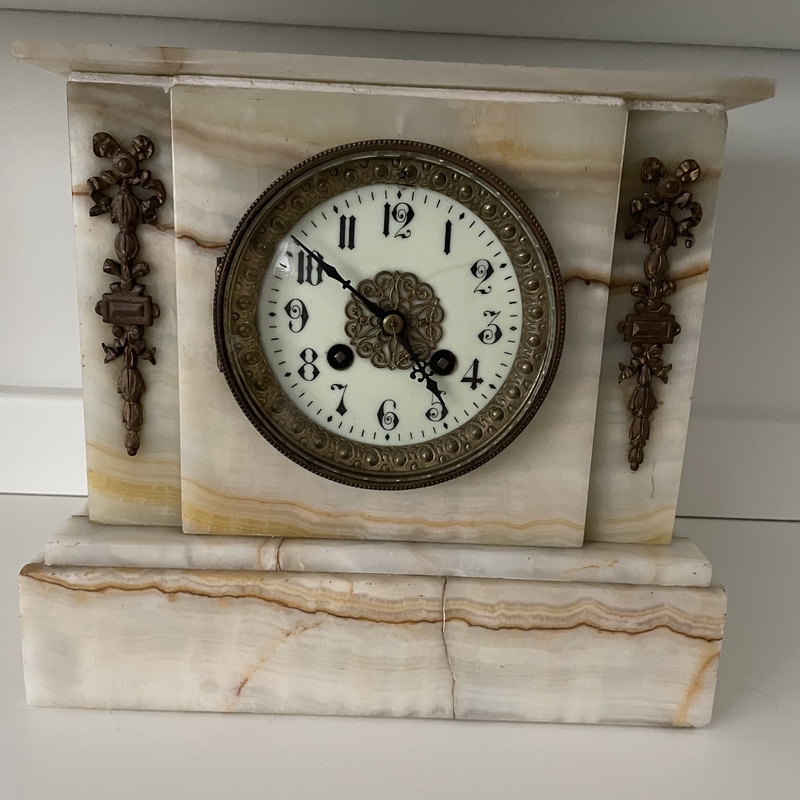





Marble clock
Marble clock
Given to my great grandparents as a wedding gift in 1894
Inherited
Maybe


Hello Sarah,
Thank you for sending in this family heirloom mantel clock to mearto.com for an appraisal.
TITLE:
Victorian, Dore bronze, white and tan marble (actually Belgian limestone), two train, double barrel springs, eight-day time and hour and half hourly striking mantel clock, made by Samuel Marti & Cie (& Company), Montbeliard and Paris, likely made in Paris circa 1880-1890.
PROVENANCE:
“Given to my great grandparents as a wedding gift in 1894”.
DESCRIPTION:
CASE: – 10in x 5in x and 10in. This is a square shaped mantel clock with a flat overhung white marble pediment at the top. The white and veined tan marble façade of the main case is square and thrust forward in the center of the casing. The facade centers the dial with its glazed knurled edge and egg-and-dart ornamental brass bezel. The façade is flanked by two recessed side panels embellished with Dore bronze, vertically aligned, tied floral bows from which hang bellflowers with most of the original gilding gone. The side panels of the case are made up of thin slabs of white marble veined with brown and tan marble streaks. It was the French method to support these marble slabs and secure them to the case with cement, and that is how this case was constructed. When looking inside the case from the round fenestrated rear door looking towards the back of the dial you can see a concrete colored substance, and that is precisely what holds the entire case together. Only the French casemakers used this method and it identifies the clock as being French made as surely as a valid signature. The brass fenestrated door is typically French and is skeletonized to allow the chiming to enter into the room more easily. There is a single step down to the broad white variegated marble base moulding which sits flat to the surface without feet. Unfortunately an obvious vertical crack is seen at the front of the base.
DIAL: This is a round white porcelain dial with black enameled ‘stylized’ Arabic hours, open bar minute track with black diamond shapes markers placed every five minutes, and a variant of steel French “Simple Roman” hands. (It is possible that the hour hand may at one time have been replaced) There is a small Brocot aperture above the twelve position, with an arbor for adjusting the speed of the movement from the dial side which makes the clock run faster and slower. (Achille Brocot invented this way of altering the speed of the movement from the dial side in 1841, and it came into general use in France in the 1850s.) There is an applied open brass fretwork at the dial center in the form of a rosette. The dial is unsigned.
MOVEMENT: This is a round solid brass plate movement with brass tubular pillars connecting the front and rear plates. The plates are pinned together at the back plate, anchor escapement, steel cut pinions, while two-barrel springs power the clock for eight days and cause striking on the coiled steel Cathedral gong on the hour and half hour. There is no evidence of a countwheel (for striking) on the back plate of this movement suggesting a date of manufacture post 1880. The pendulum hangs from the Brocot pendulum spring suspension at the top of the back plate. Brocot invented the spring shoulders from which the pendulum hangs in 1865 and they (the brass shoulders) cause a clicking sound when the speed is adjusted faster or slower. The movement is signed at the bottom of the rear brass plate with a cast medallion. It is the award won by the firm of Samuel Marti & Cie for a bronze medal at the Paris Exposition of 1860, and this medallion was placed on Marti movements for at least three decades after the event. (Therefore, you cannot use the 1860 date to date a particular clock.)
CONDITION:
Case – The marble case has a vertical crack in the base which is quite apparent. There are areas of roughness, scuffs and chipping on the rear of the case. However, the overall condition when compared to its age is quite good. The presence of concrete inside the case is noted.
Dial – The dial appears to be original except for (possibly) the hour hand which I think is a replacement. However, the main problem with the dial is a hairline fracture running from the rosette in the dial center to the ten minute marker. Overall, fair to good condition.
Movement – Appears to be original to this case, genuine and is said to be in running and chiming condition. It is fully signed by with the S. Marti medallion which not only gives the name of the firm but mention two medals, one was bronze and in another competition they won a gold medal.
~HISTORY of SAMUEL MARTI:
First mentioned in association with Roux and Japy Freres in 1867 as Japy, Marti & Roux @ Boulevard du Prince, Paris. This was a business outlet in Paris for the products of all three companies, working together in Paris to increase clock production for the retail market. Marti is mentioned first as a maker of roulants (roughed out movements) and escapements. He is associated with the production of carriage clocks. The Marti firm was originally in Montbeliard, near the Swiss border close to Basel and Zurich. However, the firm is listed at Rue Vieille-du-Temple, Paris, from 1870-1890. Stated awards include: 1839 (honorable mention), 1841 (gold medal, Paris), 1852 (gold medal, Paris), 1855 (Second Class medal), 1860 (Bronze medal Paris), 1889 Silver medal, Paris), 1900 (gold medal, Paris), 1931 (Grand Prix, Paris). The firm name lasted into the 20th century and was eventually taken over by L'Epee, maker of carriage clock movements into the late 20th century.
~HISTORY, MARBLE CASE CLOCKS:
Although marble and onyx had always been popular on the continent of Europe by the mid-19th century there was a widespread desire and vogue for these materials in mantel clocks. By midcentury, factory methods increased the production of clock movements geometrically and the development of the mechanical saw made it possible for thin sheets of marble to be cut in large quantities to house these clock movements. At the same time in France there was a great demand for ebonized furniture. The prolonged appeal of this style of case may be related to the loss of Queen Victoria's husband, Prince Albert, along with the neoclassical furniture shown at the Paris Exposition of 1867.
Frequently the term "French marble" is actually, to be perfectly accurate, "Belgian limestone". The Ardennes district of Belgium possesses large deposits of a hard limestone with a great variety of colors. So the term marble is a general term mostly referring to the mined stone from Belgian quarries and transported the short distance to French factories. Some of the "marble" cases were also made of slate (found in the north of Wales) and from marble quarries in Derbyshire. Eventually most "marble" cases were made by large numbers of workers employed in Belgium and France simply because their workmanship was superior to any of the mined stone in the U.K or any other European countries. Their work was specialized and done far less expensively than found anywhere else.
The French marble cases are made in several parts, some solid, some hollow. The thin slabs of marble are glued to a cement carcass, and sometimes a wooden base. Sometimes a zinc tube encloses the movement to prevent dust entering it from the interior of the case. The majority of black Belgian marble cases house either French or German movements
PRICE COMPARABLES:
https://www.liveauctioneers.com/item/102290948_antique-french-vincentiandcie-white-marble-mantel-clock (passed at auction because it failed to reach $300 in 2021)
https://www.liveauctioneers.com/item/93955340_french-mantel-clock (sold for $500 in 2020)
https://www.liveauctioneers.com/item/87181823_splendid-french-white-marble-19th-century-mantle-clock (failed to reach $600 minimum and was passed in 2020)
https://www.liveauctioneers.com/item/86101103_french-mantel-clock (Sold for $275 in 2020)
https://www.liveauctioneers.com/item/82989995_a-fine-french-ormolu-and-marble-mantel-clock-baschet (Sold for $600 in 2020 with a sculpted figure atop the case)
https://www.liveauctioneers.com/item/69936547_a-late-19th-century-french-white-marble-and-gilt-bronze (Sold for $473 in 2019)
https://www.liveauctioneers.com/item/58975084_french-white-marble-and-onyx-mantel-clock-19th-c-of (Sold for $125 in 2018)
https://www.liveauctioneers.com/item/87509954_japy-freres-french-alabaster-mantel-clock (Sold for $375 in 2020)
https://www.liveauctioneers.com/item/86450165_antique-alabaster-and-bronze-mounted-mantel-clock (failed to sell with minimum of 300 Canadian dollars)
PRICING:
This is a fine family heirloom dating back to at least 1894 when your grandparents married. It has some case blemishes and a tight crack in the dial but it is an honest clock with little done to it (except perhaps for the hour hand). It remains simple, and yet refined and classically French in its aesthetic appeal. Comparing it to similar mantel clocks I believe the fair market value if offered at auction or for sale today would be in the $275-$350 range with retail prices about twice that amount.
Thank you for choosing mearto.com for you appraisal. I hope you continue to enjoy this family heirloom clock.
My best,
David
I don’t see where to remove the bell. The clock is in perfect working order and chimes every 15 minutes.
Sarah,
That is because this clock does not have a bell. It has a coiled chime. however, I did find the name of the clockmaker on a small medallion on the back movement plate.
Thank you for getting me those images and the dimensions.
I just finished two other appraisals and just saw your photos and message. I will get this done for you sometime tomorrow for sure.
Thank you for helping
David

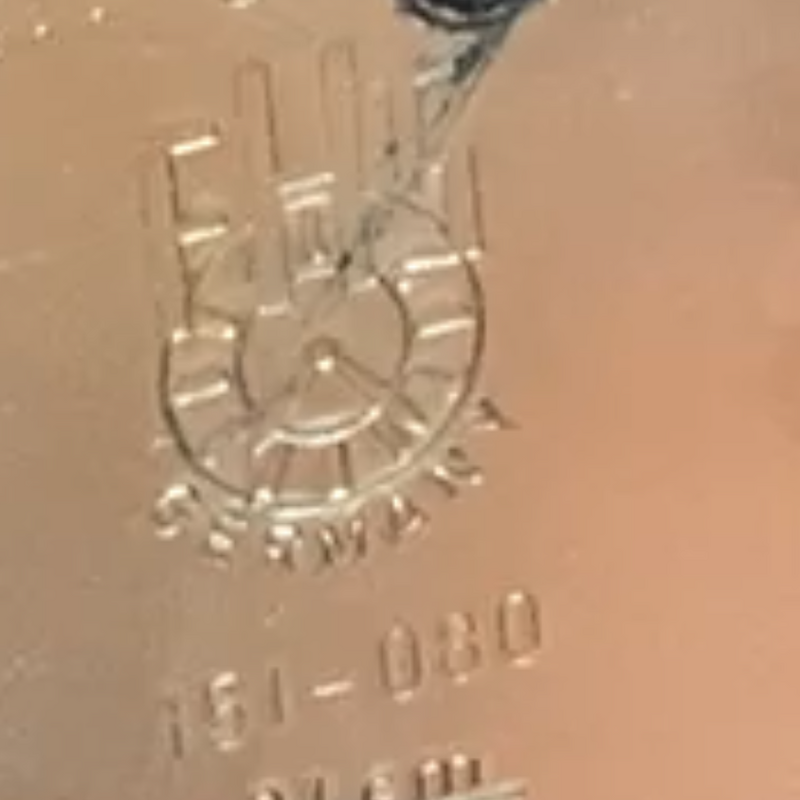
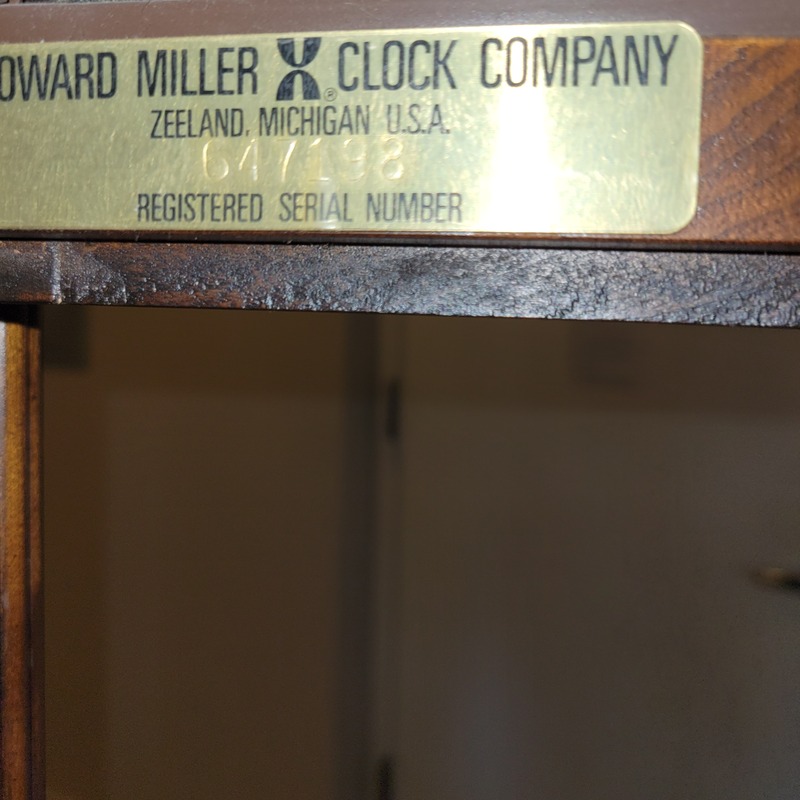

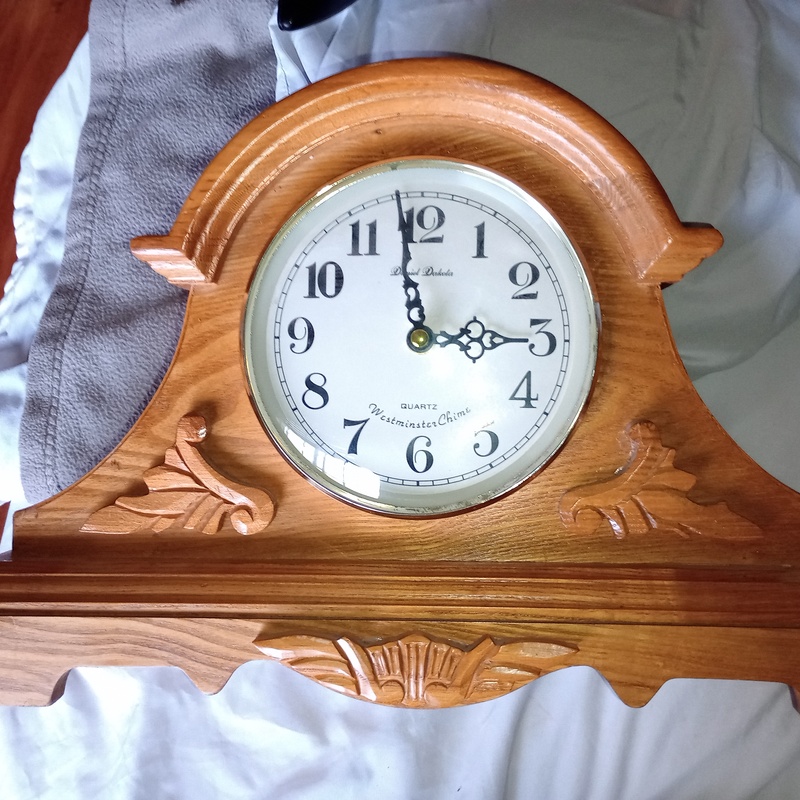
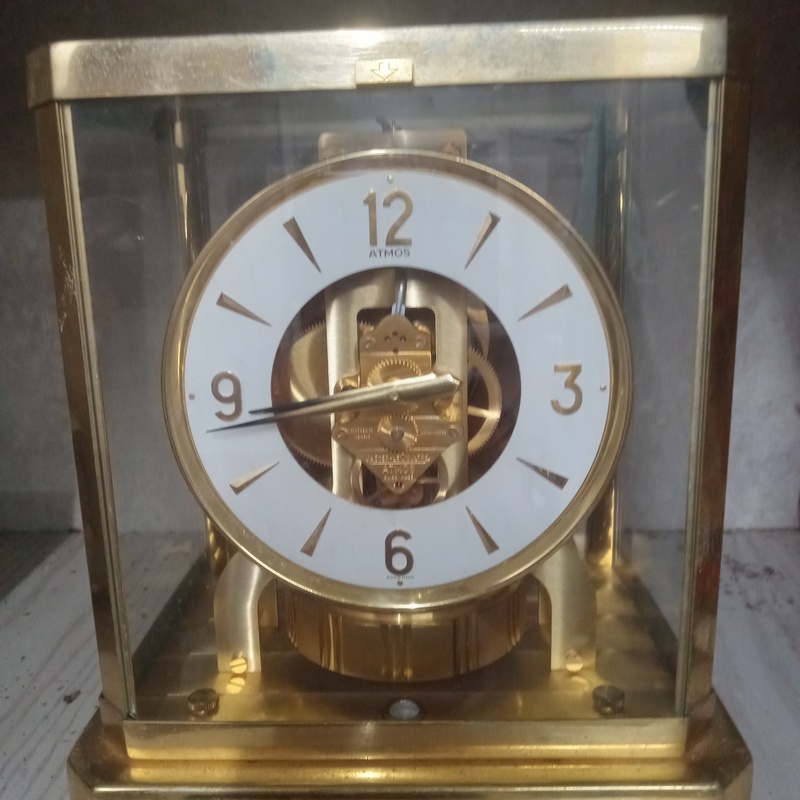


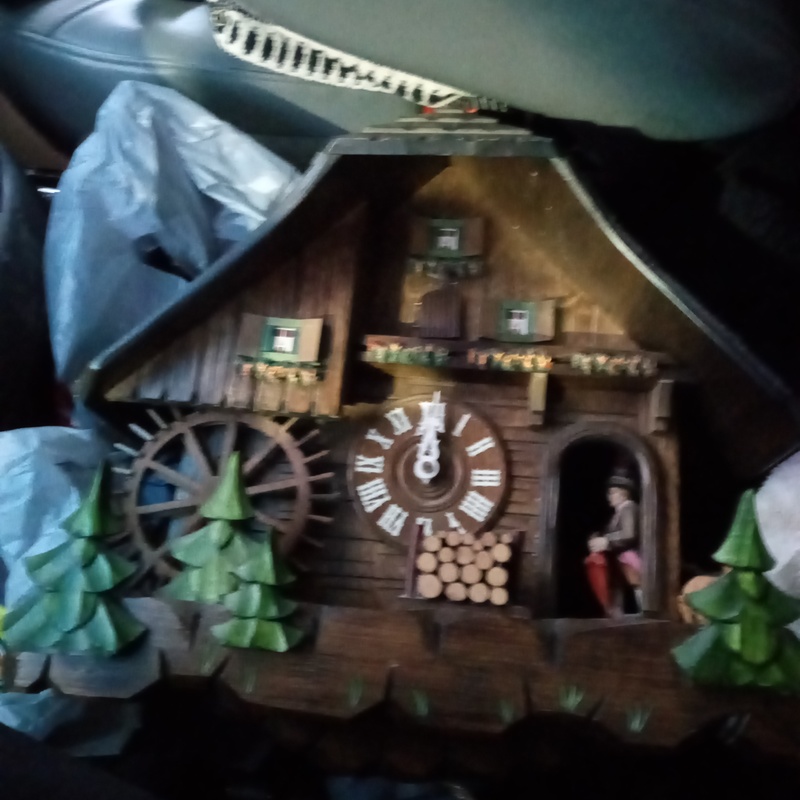

The clock is 10in wide 5in deep and 10in high